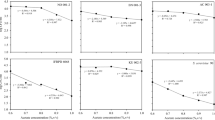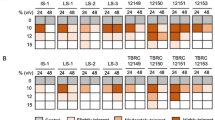Abstract
A thermotolerant ethanol fermenting yeast strain is a key requirement for effective ethanol production at high temperature. This work aimed to select a thermotolerant yeast producing a high ethanol concentration from molasses and increasing its ethanol production by mutagenesis. Saccharomyces cerevisiae DMKU 3-S087 was selected from 168 ethanol producing strains because it produced the highest ethanol concentration from molasses at 40 °C. Optimization of molasses broth composition was performed by the response surface method using Box–Behnken design. In molasses broth containing optimal total fermentable sugars (TFS) of 200 g/L and optimal (NH4)2SO4 of 1 g/L, with an initial pH of 5.5 by shaking flask cultivation at 40 °C ethanol, productivity and yield were 58.4 ± 0.24 g/L, 1.39 g/L/h and 0.29 g/g, respectively. Batch fermentation in a 5 L stirred-tank fermenter with 3 L optimized molasses broth adjusted to an initial pH of 5.5 and fermentation controlled at 40 °C and 300 rpm agitation resulted in 72.4 g/L ethanol, 1.21 g/L/h productivity and 0.36 g/g yield at 60 h. Strain DMKU 3-S087 improvement was performed by mutagenesis using ultraviolet radiation and ethyl methane sulfonate (EMS). Six EMS mutants produced higher ethanol (65.2 ± 0.48–73.0 ± 0.54 g/L) in molasses broth containing 200 g/L TFS and 1 g/L (NH4)2SO4 by shake flask fermentation at 37 °C than the wild type (59.8 ± 0.25 g/L). Among these mutants, only mutant S087E100-265 produced higher ethanol (62.5 ± 0.26 g/L) than the wild type (59.5 ± 0.02 g/L) at 40 °C. In addition, mutant S087E100-265 showed better tolerance to high sugar concentration, furfural, hydroxymethylfurfural and acetic acid than the wild type.







Similar content being viewed by others
References
Abdel-Banat BA, Hoshida H, Ano A, Nonklang S, Akada R (2010) High-temperature fermentation: how can processes for ethanol production at high temperatures become superior to the traditional process using mesophilic yeast? Appl Microbiol Biotechnol 85:861–867
Abubaker HO, Sulieman AME, Elamin HB (2012) Utilization of Schizosaccharomyces pombe for production of ethanol from cane molasses. J Microbiol Res 2:36–40
Almeida JR, Modig T, Petersson A, Hähn-Hägerdal B, Lidén G, Gorwa-Grauslund MF (2007) Increased tolerance and conversion of inhibitors in lignocellulosic hydrolysates by Saccharomyces cerevisiae. J Chem Technol Biotechnol 82:340–349
Auesukaree C, Koedrith P, Saenpayavai P, Asvarak T, Benjaphokee S, Sugiyama M, Kaneko Y, Harashima S, Boonchird C (2012) Characterization and gene expression profiles of thermotolerant Saccharomyces cerevisiae isolates from Thai fruits. J Biosci Bioeng 114:144–149
Banat IM, Nigam P, Singh D, Marchant R, McHale AP (1998) Review: ethanol production at elevated temperatures and alcohol concentrations: part I—yeasts in general. World J Microbiol Biotechnol 14:809–821
Boyer LJ, Vega JL, Klasson KT, Clausen EC, Gaddy JL (1992) The effects of furfural on ethanol production by Saccharomyces cereyisiae in batch culture. Biomass Bioenergy 3:41–48
Bro C, Regenberg B, Forster J, Nielsen J (2006) In silico aided metabolic engineering of Saccharomyces cerevisiae for improved bioethanol production. Metab Eng 8:102–111
Brooks AA (2008) Ethanol production potential of local yeast strains isolated from ripe banana peels. Afr J Biotechnol 7:3749–3752
Ҫakar F, Ӧzer I, Özhan Aytekin A, Şahin F (2014a) Improvement production of bacterial cellulose by semi-continuous process in molasses medium. Carbohydr Polym 106:7–13
Ҫakar F, Ӧzer I, Özhan Aytekin A, Şahin F (2014b) Improvement production of bacterial cellulose by semi-continuous process in molasses medium. Carbohydr Polym 106:7–13
Capiaghi C, Ho V, Thoma F (2004) Kinetochores prevent repair of UV damage in Saccharomyces cerevisiae centromeres. Mol Cell Biol 24:6907–6918
Chi Z, Arnebory N (2000) Saccharomyces cerevisiae strains with different degrees of ethanol tolerance exhibit different adaptive responses to produced ethanol. J Ind Microbiol Biotechnol 24:75–78
Choi GW, Um HJ, Kim Y, Kang HW, Kim M, Chung BW, Kim YH (2010) Isolation and characterization of two soil derived yeasts for bioethanol production on cassava starch. Biomass Bioenergy 34:1223–1231
Curran BPG, Khalawan SA (1994) Alcohols lower the threshold temperature for the maximal activation of a heat shock expression vector in the yeast Saccharomyces cerevisiae. Microbiology 140:2225–2228
Dhaliwal SS, Oberoi HS, Sandhu SK, Nanda D, Kumar D, Uppal SK (2011) Enhanced ethanol production from sugarcane juice by galactose adaptation of a newly isolated thermotolerant strain of Pichia kudriavzevii. Bioresour Technol 102:5968–5975
Edgardo A, Carolina P, Manuel R, Juanita F, Jaime B (2008) Selection of thermotolerant yeast strains Saccharomyces cerevisiae for bioethanol production. Enzyme Microb Technol 43:120–123
French CT, Ross CD, Keysar SB, Joshi DD, Lim CU, Fox MH (2006) Comparison of the mutagenic potential of 17 physical and chemical agents analyzed by the flow cytometry mutation assay. Mutat Res 602:14–25
Gasmalla MAA, Yang R, Nikoo M, Man S (2012) Production of ethanol from Sudanese sugar cane molasses and evaluation of its quality. J Food Process Technol 3:1–3
Gibson BR, Lawrence SJ, Leclair JP, Powell CD, Smart KA (2007) Yeast responses to stresses associated with industrial brewery handling. FEMS Microbiol Rev 31:535–569
Hamouda HI, Nassar HN, Madian HR, Abu Amr SS, EI-Gendy NS (2015a) Statistical optimization of batch ethanol fermentation of sugarcane molasses by Candida tropicalis strain HSC-24. Int J Chemtech Res 8:878–889
Hamouda HI, Nassar HN, Madian HR, Abu Amr SS, EI-Gendy NS (2015b) Response surface optimization of bioethanol production from sugarcane molasses by Pichia veronae strain HSC-22. Biotechnol Res Int 2015:905792
Hu N, Yuan B, Sun J, Wang SA, Li FL (2012) Thermotolerant Kluyeromyces marxianus and Saccharomyces cerevisiae strains representing potentials for bioethanol production from Jerusalem artichoke by consolidated bioprocessing. Appl Microbiol Biotechnol 95:1359–1368
Hughes SR, Gibbons WR, Bang SS, Pinkelman R, Bischoff KM, Slininger PJ, Qureshi N, Kurtzman CP, Liu SQ, Saha BC, Jackson JS, Catta MA, Rich JO, Javers JE (2012) Random UV-C mutagenesis of Scheffersomyces (formerly Pichia) stipitis NRRL Y-7124 to improve anaerobic growth on lignocellulosic sugars. J Ind Microbiol Biotechnol 39:163–173
Kurtzman CP (2011) Pichia E.C. Hansen (1904). In: Kurtzman CP, Fell JW, Boekhout T (eds) The yeasts, a taxonomic study, 5th edn. Elsevier, Amsterdam, pp 685–707
Kurtzman CP, Robnett CJ (1998) Identification and phylogeny of ascomycetous yeasts from analysis of nuclear large subunit (26 S) ribosomal DNA partial sequences. Anton Leeuw 73:331–371
Limtong S, Sringiew C, Yongmanitchai W (2007a) Production of fuel ethanol at high temperature from sugar cane juice by a newly isolated Kluyveromyces marxianus. Bioresour Technol 98:3367–3374
Limtong S, Yongmanitchai W, Tun MM, Kawasaki H, Seki T (2007b) Kazachstania siamensis sp. nov., an ascomycetous yeast species from forest soil in Thailand. Int J Syst Evol Microbiol 57:419–422
Mobini-Dehkordi M, Nahvi I, Zarkesh-Esfahani H, Ghaedi K, Tavassoli M, Akada R (2008) Isolation of a novel mutant strain of Saccharomyces cerevisiae by an ethyl methane sulfonate-induced mutagenesis approach as a high producer of bioethanol. J Biosci Bioeng 105:403–408
Modig T, Liden G, Taherzadeh MJ (2002) Inhibition effects of furfural on alcohol dehydrogenase, aldehyde dehydrogenase and pyruvate dehydrogenase. Biochem J 363:769–776
Morimura S, Ling ZY, Kida K (1997) Ethanol production by repeated-batch fermentation at high temperature in a molasses medium containing a high concentration of total sugar by a thermotolerant flocculating yeast with improved salt-tolerance. J Ferment Bioeng 83:271–274
Nigam PS, Singh A (2011) Production of liquid biofuels from renewable resources. Prog Energy Combust Sci 37:52–68
Nitiyon S, Keo-oudone C, Murata M, Lertwattanasakul N, Limtong S, Kosaka T, Yamada M (2016) Efficient conversion of xylose to ethanol by stress tolerant Kluyeromyces marxianus BUNL-21. Springerplus 5:185
Nuanpeng S, Thanonkeo S, Yamada M, Thanonkeo P (2016) Ethanol production from sweet sorghum juice at high temperatures using a newly isolated thermotolerant yeast Saccharomyces cerevisiae DBKKU Y-53. Energies 9:253
Phong HX, Giang NTC, Nitiyon S, Yamada M, Thanonkeo P, Dung NTP (2016) Ethanol production from molasses at high temperature by thermotolerant yeasts isolated from cocoa. Can Tho Univ J Sci 3:32–37
Phutela UG, Kaur J (2014) Process optimization for ethanol production from sweet sorghum juice using Saccharomyces cerevisiae strain NRRLY-2034 by response surface methodology. Sugar Tech 16:411–421
Shahsavarani H, Sugiyama M, Kaneko Y, Chuenchit B, Harashima S (2012) Superior thermotolerance of Saccharomyces cerevisiae for efficient bioethanol fermentation can be achieved by overexpression of RSP5 ubiquitin ligase. Biotechnol Adv 30:1289–1300
Spencer J, Phister TG, Smart KA, Greetham D (2014) Tolerance of pentose utilising yeast to hydrogen peroxide-induced oxidative stress. BMC Res Notes 7:151
Sree NK, Sridhar M, Suresh K, Banat IM, Venkateswar Rao L (2000) Isolation of thermotolerant, osmotolerant, flocculating Saccharomyces cerevisiae for ethanol production. Bioresour Technol 72:43–46
Sridhar M, Sree NK, Rao LV (2002) Effect of UV radiation on thermotolerant, ethanol tolerance and osmotolerant of Saccharomyces cerevisiae VS1 and VS3 strains. Bioresour Technol 83:199–202
Srimachai T, Nuithitikul K, O-thong S, Kongjan P, Panpong K (2015) Optimization and kinetic modeling of ethanol production from oil palm frond juice in batch fermentation. Energy Procedia 79:111–118
Suutari M, Liukkonen K, Laakso S (1990) Temperature adaptation in yeasts: the role of fatty acids. J Gen Microbiol 136:1469–1474
Taherzadeh MJ, Karimi K (2011) Fermentation inhibitors in ethanol processes and different strategies to reduce their effects. In: Pandey A, Larroche C, Ricke SC, Dussap CG, Gnansounou E (eds) Receptor localization. Elsevier, Burlington, pp 287–311
Techaparin A, Thanonkeo P, Klanrit P (2017) High-temperature ethanol production using thermotolerant yeast newly isolated from Greater Mekong Subregion. Braz J Microbiol 48:461–475
Tian S, Zhu J, Yang X (2011) Evaluation of an adapted inhibitor-tolerant yeast strain for ethanol production from combined hydrolysate of softwood. Appl Energy 88:1792–1796
Verghese J, Abrams J, Wang Y, Morano KA (2012) Biology of the heat shock response and protein chaperones: budding yeast (Saccharomyces cerevisiae) as a model system. Microbiol Mol Biol Rev 76:115–158
Watanabe T, Srichuwong S, Arakane M, Tamiya S, Yoshinaga M, Watanabe I, Yamamoto M, Ando A, Tokuyasu K, Nakamura T (2010) Selection of stress-tolerant yeasts for simultaneous saccharification and fermentation (SSF) of very high gravity (VHG) potato mash to ethanol. Bioresour Technol 101:9710–9714
Watanabe T, Watanabe I, Yamamoto M, Ando A, Nakamura T (2011) A UV-induced mutant of Pichia stipitis with increased ethanol production from xylose and selection of a spontaneous mutant with increased ethanol tolerance. Bioresour Technol 102:1844–1848
Yuangsaard N, Yongmanitchai W, Yamada M, Limtong S (2013) Selection and characterization of a newly isolated thermotolerant Pichia kudriavzevii strain for ethanol production at high temperature from cassava starch hydrolysate. Anton Leeuw 103:577–588
Zabed H, Sahu JN, Suely A, Boyce AN, Faruq G (2017) Bioethanol production from renewable sources: current perspectives and technological progress. Renew Sust Energy Rev 71:475–501
Zhang M, Zhu R, Zhang M, Wang S (2014) Creation of an ethanol-tolerant Saccharomyces cerevisiae strain by 266 nm laser radiation and repetitive cultivation. J Biosci Bioeng 118:508–513
Zhang M, Shi J, Jiang L (2015) Modulation of mitochondrial membrane integrity and ROS formation by high temperature in Saccharomyces cerevisiae. Electron J Biotechnol 18:202–209
Funding
This work was supported by the research grant from the Faculty of Science, Kasetsart University, Bangkok, Thailand and the Thailand Research Fund through the TRF Research-Team Promotion Grant RTA6080004.
Author information
Authors and Affiliations
Contributions
SP: Performed research and wrote the paper, NL: Data discussion and checking the paper, MY: Data discussion and checking the paper, SL: Designed study, data discussion and wrote the paper.
Corresponding author
Ethics declarations
Conflict of interest
The authors declare that there are no conflicts of interest.
Ethical approval
This article does not contain any studies with human participants or animals performed by any of the authors.
Additional information
Publisher's Note
Springer Nature remains neutral with regard to jurisdictional claims in published maps and institutional affiliations.
Rights and permissions
About this article
Cite this article
Pattanakittivorakul, S., Lertwattanasakul, N., Yamada, M. et al. Selection of thermotolerant Saccharomyces cerevisiae for high temperature ethanol production from molasses and increasing ethanol production by strain improvement. Antonie van Leeuwenhoek 112, 975–990 (2019). https://doi.org/10.1007/s10482-019-01230-6
Received:
Accepted:
Published:
Issue Date:
DOI: https://doi.org/10.1007/s10482-019-01230-6




